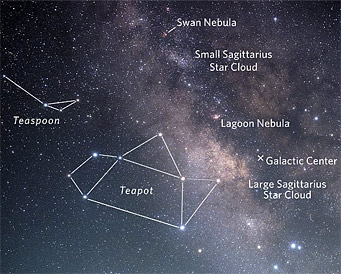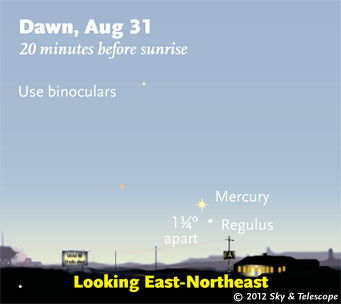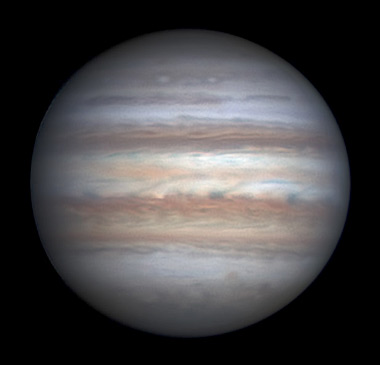Friday, August 24

Right after dark the Sagittarius Teapot stands highest in the south, with the Large Sagittarius Star Cloud above its spout like a puff of steam. Binoculars will show the two nebulae labeled here, before the moonlight gets too bright later this week. Click image for larger view.
Akira Fujii
Saturday, August 25
Sunday, August 26
Monday, August 27
Tuesday, August 28
Wednesday, August 29
Thursday, August 30

Mercury and Regulus may not be easy to spot even with binoculars as the sky brightens about 20 minutes before sunrise.
Sky & Telescope diagram
Friday, August 31
Saturday, September 1
Want to become a better amateur astronomer? Learn your way around the constellations. They're the key to locating everything fainter and deeper to hunt with binoculars or a telescope.
For an easy-to-use constellation guide covering the whole evening sky, use the big monthly map in the center of each issue of Sky & Telescope, the essential guide to astronomy. Or download our free Getting Started in Astronomy booklet (which only has bimonthly maps).
Sky Atlas 2000.0 (the color Deluxe Edition is shown here) plots 81,312 stars to magnitude 8.5. That includes most of the stars that you can see in a good finderscope, and typically one or two stars that will fall within a 50× telescope's field of view wherever you point. About 2,700 deep-sky objects to hunt are plotted among the stars.
Alan MacRobert
Once you get a telescope, to put it to good use you'll need a detailed, large-scale sky atlas (set of charts). The standards are the little Pocket Sky Atlas, which shows stars to magnitude 7.6; the larger and deeper Sky Atlas 2000.0 (stars to magnitude 8.5); and the even larger Uranometria 2000.0 (stars to magnitude 9.75). And read how to use sky charts with a telescope effectively.
You'll also want a good deep-sky guidebook, such as Sue French's Deep-Sky Wonders collection (which includes its own charts), Sky Atlas 2000.0 Companion by Strong and Sinnott, the bigger Night Sky Observer's Guide by Kepple and Sanner, or the classic if dated Burnham's Celestial Handbook.
Can a computerized telescope replace charts? I don't think so — not for beginners, anyway, and especially not on mounts and tripods that are less than top-quality mechanically (able to point with better than 0.2° repeatability). As Terence Dickinson and Alan Dyer say in their invaluable Backyard Astronomer's Guide, "A full appreciation of the universe cannot come without developing the skills to find things in the sky and understanding how the sky works. This knowledge comes only by spending time under the stars with star maps in hand."
This Week's Planet Roundup
Mercury (about magnitude –1.2) remains in view at dawn but lower each day. It's above the east-northeast horizon, far lower left of brilliant Venus. Look about 45 minutes before sunrise, the earlier in the week the better.
(You can always find your local sunrise/sunset times once you put your location into our online almanac. If you're on daylight saving time, make sure the Daylight Saving Time box is checked.)
Venus (magnitude –4.3, in Gemini) rises in deep darkness around 3 a.m. daylight saving time (depending on where you are), emerging above the east-northeast horizon like a UFO a good two hours before the first glimmer of dawn. By dawn it's blazing high in the east — vastly outshining Pollux and Castor to its left and Procyon below it or to its lower right.
Mars, Saturn, and Spica (in Virgo, similar at magnitudes 1.2, 0.8, and 1.0 respectively) form a lengthening triangle low in the west-southwest at dusk. Mars is pulling away to the left of the other two. Look for them far lower left of Arcturus.

The side of Jupiter away from the Great Red Spot on August 23rd. South is up. The huge, reddish northern-hemisphere belt is resolving itself back into the North Equatorial Belt and, below it here, the North Temperate Belt, with the light North Tropical Zone re-forming between them. Notice the thin, unusual Equatorial Band in the middle of the bright Equatorial Zone.
Jupiter (magnitude –2.3, in Taurus) rises in the east-northeast around midnight daylight saving time. Once it's well clear of the horizon, look for fainter orange Aldebaran twinkling 6° to its right or lower right. By dawn Jupiter shines very high in the southeast, about 35° upper right of even brighter Venus.
Uranus (magnitude 5.7, at the Pisces-Cetus border) and Neptune (magnitude 7.8, in Aquarius) reach good heights in the southeast by late evening. Finder charts for Uranus and Neptune.
All descriptions that relate to your horizon — including the words up, down, right, and left — are written for the world's mid-northern latitudes. Descriptions that also depend on longitude (mainly Moon positions) are for North America. Eastern Daylight Time (EDT) equals Universal Time (also known as UT, UTC, or GMT) minus 4 hours.
Like This Week's Sky at a Glance? Watch our weekly SkyWeek TV short. It's also playing on PBS!
To be sure to get the current Sky at a Glance, bookmark this URL:
http://SkyandTelescope.com/observing/ataglance?1=1
If pictures fail to load, refresh the page. If they still fail to load, change the 1 at the end of the URL to any other character and try again.
 0
0
Comments
You must be logged in to post a comment.